Ø1" UV Fused Silica Best Form Spherical Lenses, Uncoated
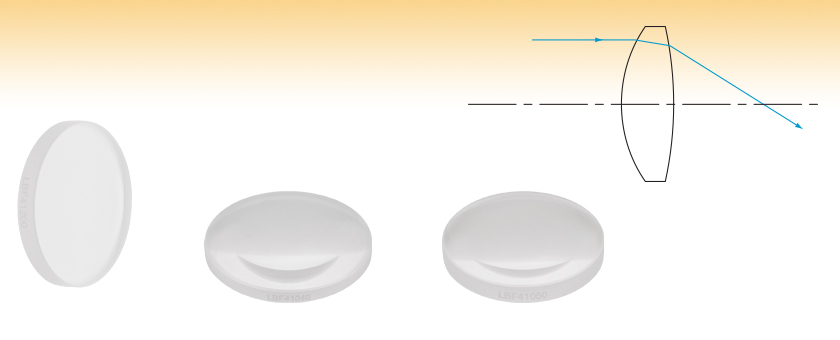
- Best Possible Performance from a Spherical Singlet
- Optimized for Infinite Conjugates
- Diffraction-Limited Performance at Small Input Diameters
- Ideal for High-Power Applications
LBF41200
LBF41050
LBF41040

Please Wait
| Common Specifications | ||
|---|---|---|
| Lens Shape | Convex / Convex | |
| Material | UV-Grade Fused Silicaa | |
| Wavelength Range | 185 nm - 2.1 μm (Uncoated) | |
| Design Wavelength | 587.6 nm | |
| Index of Refraction | 1.458 @ Design Wavelength | |
| Centration | ≤3 arcmin | |
| Clear Aperture | >90% of Diameter | |
| Diameter Tolerance | +0.0 mm / -0.1 mm | |
| Focal Length Tolerance | ±1% | |
| Surface Quality | 10-5 Scratch-Dig | |
| Spherical Surface Powerb | ≤3λ/2c | |
| Spherical Surface Irregularity |
≤λ/4c | |
| Click on the red Document icon next to the item numbers below to access the Zemax file download. Our entire Zemax Catalog is also available. |
Features
- Best Possible Performance from a Spherical Singlet
- Fabricated from UV-Grade Fused Silica
- Uncoated for 185 nm - 2.1 μm Transmission
- Focal Lengths Available from 40.0 mm to 200.0 mm
- Diffraction-Limited Performance at Small Input Diameters
Thorlabs' UV-Grade Fused Silica (UVFS) Best Form Lenses are designed to minimize spherical aberration while still using spherical surfaces to form the lens. They are typically employed at infinite conjugates in high-power applications where doublets are not an option. The best form lenses available on this page are fabricated from uncoated UVFS; please see the selection guide below to view our complete selection of best form lenses.
UV-grade fused silica offers high transmission in the deep UV and exhibits virtually no laser-induced fluorescence (as measured at 193 nm), making it an ideal choice for applications from the UV to the near IR. In addition, UV fused silica has better homogeneity and a lower coefficient of thermal expansion than N-BK7.
For spherical lenses, a given focal length can be produced by more than one combination of the front and back radii of curvature. Each combination of surface curvatures will result in a different amount of aberration caused by the lens. The radius of curvature for each surface of these best form lenses has been chosen to minimize the spherical aberration and coma produced by the lens, optimizing it for use at infinite conjugates. This process makes these lenses more expensive than plano-convex or bi-convex lenses, but still significantly less expensive than our premium line of CNC-polished aspheric lenses. Since the lenses are optimized for minimum spot size, they can theoretically reach diffraction-limited performance for small input beam diameters (see the table below and to the right for details).
For best performance in focusing applications, place the surface with the shorter radius of curvature (i.e., the more steeply curved surface) towards the collimated source.
| Best Form Lenses Selection Guide | |
|---|---|
| N-BK7 | UV Fused Silica |
| Uncoated | Uncoated |
| - | -UV Coating (245 - 400 nm) |
| -A Coating (350 - 700 nm) | -A Coating (350 - 700 nm) |
| - | -AB Coating (400 - 1100 nm) |
| -B Coating (650 - 1050 nm) | -B Coating (650 - 1050 nm) |
| -C Coating (1050 - 1700 nm) | -C Coating (1050 - 1700 nm) |
| Item # | Input Diameter for Diffraction-Limited Performance @ 633 nm |
Input Diameter for Diffraction-Limited Performance @ 1064 nm |
|---|---|---|
| LBF41040 | 5.0 mm | 5.1 mm |
| LBF41050 | 6.3 mm | 6.4 mm |
| LBF41075 | 9.4 mm | 9.6 mm |
| LBF41100 | 12.5 mm | 12.7 mm |
| LBF41150 | 18.8 mm | 19.1 mm |
| LBF41200 | 22.9 mma | 22.9 mma |
| Quick Links to Other Spherical Singlets | ||||||
|---|---|---|---|---|---|---|
| Plano-Convex | Bi-Convex | Best Form | Plano-Concave | Bi-Concave | Positive Meniscus | Negative Meniscus |
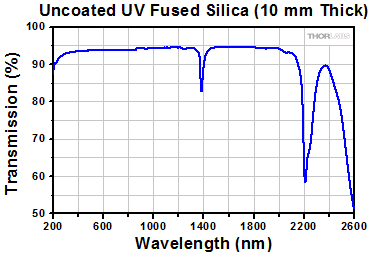
Click to Enlarge
Click Here for Raw Data
This transmission curve is for a 10 mm thick uncoated sample of UV fused silica when the incident light is normal to the surface. Please note that this is the measured transmission, including surface reflections.
| Recommended Mounting Options for Thorlabs Lenses | ||
|---|---|---|
| Item # | Mounts for Ø2 mm to Ø10 mm Optics | |
| Imperial | Metric | |
| (Various) | Fixed Lens Mounts and Mini-Series Fixed Lens Mounts for Small Optics, Ø5 mm to Ø10 mm | |
| (Various) | Small Optic Adapters for Use with Standard Fixed Lens Mounts, Ø2 mm to Ø10 mm | |
| Item # | Mounts for Ø1/2" (Ø12.7 mm) Optics | |
| Imperial | Metric | |
| LMR05 | LMR05/M | Fixed Lens Mount for Ø1/2" Optics |
| MLH05 | MLH05/M | Mini-Series Fixed Lens Mount for Ø1/2" Optics |
| LM05XY | LM05XY/M | Translating Lens Mount for Ø1/2" Optics |
| SCP05 | 16 mm Cage System, XY Translation Mount for Ø1/2" Optics | |
| (Various) | Ø1/2" Lens Tubes, Optional SM05RRC Retaining Ring for High-Curvature Lenses (See Below) |
|
| Item # | Mounts for Ø1" (Ø25.4 mm) Optics | |
| Imperial | Metric | |
| LMR1 | LMR1/M | Fixed Lens Mount for Ø1" Optics |
| LM1XY | LM1XY/M | Translating Lens Mount for Ø1" Optics |
| ST1XY-S | ST1XY-S/M | Translating Lens Mount with Micrometer Drives (Other Drives Available) |
| CXY1A | 30 mm Cage System, XY Translation Mount for Ø1" Optics | |
| (Various) | Ø1" Lens Tubes, Optional SM1RRC Retaining Ring for High-Curvature Lenses (See Below) |
|
| Item # | Mount for Ø1.5" Optics | |
| Imperial | Metric | |
| LMR1.5 | LMR1.5/M | Fixed Lens Mount for Ø1.5" Optics |
| (Various) | Ø1.5" Lens Tubes, Optional SM1.5RR Retaining Ring for Ø1.5" Lens Tubes and Mounts |
|
| Item # | Mounts for Ø2" (Ø50.8 mm) Optics | |
| Imperial | Metric | |
| LMR2 | LMR2/M | Fixed Lens Mount for Ø2" Optics |
| LM2XY | LM2XY/M | Translating Lens Mount for Ø2" Optics |
| CXY2 | 60 mm Cage System, XY Translation Mount for Ø2" Optics |
|
| (Various) | Ø2" Lens Tubes, Optional SM2RRC Retaining Ring for High-Curvature Lenses (See Below) |
|
| Item # | Adjustable Optic Mounts | |
| Imperial | Metric | |
| LH1 | LH1/M | Adjustable Mount for Ø0.28" (Ø7.1 mm) to Ø1.80" (Ø45.7 mm) Optics |
| LH2 | LH2/M | Adjustable Mount for Ø0.77" (Ø19.6 mm) to Ø2.28" (Ø57.9 mm) Optics |
| VG100 | VG100/M | Adjustable Clamp for Ø0.5" (Ø13 mm) to Ø3.5" (Ø89 mm) Optics |
| SCL03 | SCL03/M | Self-Centering Mount for Ø0.15" (Ø3.8 mm) to Ø1.77" (Ø45.0 mm) Optics |
| SCL04 | SCL04/M | Self-Centering Mount for Ø0.15" (Ø3.8 mm) to Ø3.00" (Ø76.2 mm) Optics |
| LH160CA | LH160CA/M | Adjustable Mount for 60 mm Cage Systems, Ø0.50" (Ø13 mm) to Ø2.00" (Ø50.8 mm) Optics |
| SCL60CA | SCL60C/M | Self-Centering Mount for 60 mm Cage Systems, Ø0.15" (Ø3.8 mm) to Ø1.77" (Ø45.0 mm) Optics |
Mounting High-Curvature Optics
Thorlabs' retaining rings are used to secure unmounted optics within lens tubes or optic mounts. These rings are secured in position using a compatible spanner wrench. For flat or low-curvature optics, standard retaining rings manufactured from anodized aluminum are available from Ø5 mm to Ø4". For high-curvature optics, extra-thick retaining rings are available in Ø1/2", Ø1", and Ø2" sizes.
Extra-thick retaining rings offer several features that aid in mounting high-curvature optics such as aspheric lenses, short-focal-length plano-convex lenses, and condenser lenses. As shown in the animation to the right, the guide flange of the spanner wrench will collide with the surface of high-curvature lenses when using a standard retaining ring, potentially scratching the optic. This contact also creates a gap between the spanner wrench and retaining ring, preventing the ring from tightening correctly. Extra-thick retaining rings provide the necessary clearance for the spanner wrench to secure the lens without coming into contact with the optic surface.
| Posted Comments: | |
| No Comments Posted |

 Products Home
Products Home






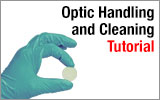
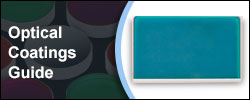
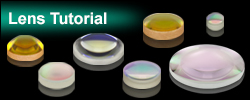
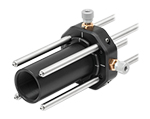
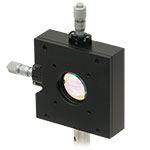
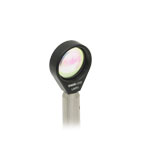
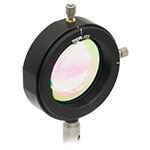
 UV Fused Silica, Uncoated
UV Fused Silica, Uncoated